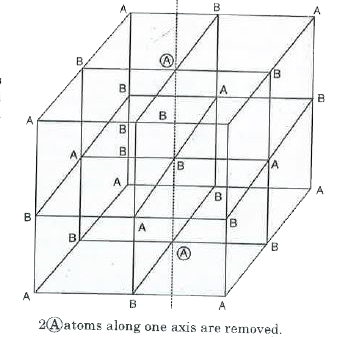If a solid 'AB','A' atoms have ccp arrangement and B atoms occupy all the octahedral sites. If all the face centred atoms along one of the axes are removed, then what will be the resultant stoichiometry of the compound?

In ccp type structure, there are 8A at the corners of the cube and 6A atoms on the face centres. If all the face centred atoms along one of the axes are removed, it means removal of 2A atoms. Therefore, only 4 atoms will be left on faces .
No. of A atoms per unit cell = 8×18+4×12=3
No. of B atoms in ccp structure are 12 at edge centred and 1 at body centre. therefore,
No. of B atoms per unit cell = 12×14+1=4
∴ Stoichiometry of compound = A3B4.
Topper's Solved these Questions
- SOLID STATEBOOK - MODERN PUBLICATIONCHAPTER - SOLID STATEEXERCISE - CONCEPTUAL QUESTIONS 2
21 Videos
- SOLID STATEBOOK - MODERN PUBLICATIONCHAPTER - SOLID STATEEXERCISE - ADVANCED LEVEL PROBLEMS
8 Videos
- SOLID STATEBOOK - MODERN PUBLICATIONCHAPTER - SOLID STATEEXERCISE - PRACTICE PROBLEMS
48 Videos
- POLYMERSBOOK - MODERN PUBLICATIONCHAPTER - POLYMERSEXERCISE - Competition file (OBJECTIVE TYPE QUESTIONS) (C. MULTIPLE CHOICE QUESTIONS)(Integer Type Questions)
6 Videos
- SOLUTIONSBOOK - MODERN PUBLICATIONCHAPTER - SOLUTIONSEXERCISE - UNIT PRACTICE TEST
14 Videos
Similar Questions
In a solid AB, A atoms have a ccp arrangement and B atoms occupy all the octahedral sites. If all the face-centred atoms along one of the axes passing through body centres are removed, then what will be the resultant stoichiometry of compound ?
View SolutionIn a solid AB having the NaCl structure, A atom occupies the corners of the cubic unit cell. If all the face-centred atoms along one of the axes are removed, then the resultant stoichiometry of the solid is
View Solution
Knowledge Check
In a solid AB having the NaCl structure, A atom occupies the corners of the cubic unit cell. If all the face-centred atoms along one of the axes are removed, then the resultant stoichiometry of the solid is
AAB2BA2BCA4B3DA3B4In a solid AB having the NaCl structure, A atom occupies the corners of the cubic unit cell. If all the face-centred atoms along one of the axes are removed, then the resultant stoichiometry of the solid is
AAB2BA2BCA4B3DA3B4In a solid 'AB' having rock salt arrangement (NaCl structure), 'A' atoms occupy the corners and face center of the cubic unit cell. 'B' atoms occupies all octahedral voids of the unit cell. If all the face - centered atoms along one of the axes are removed, then the resultant stoichiometry of the solid is
AAB2BA2BCA4B3DA3B4
In a solid AB having the NaCl structure, A atoms occupy the corners of the cubic unit cell. If all the face-centred atoms along one of the axes are removed, then the resultant stoichiometry of the solid is
View SolutionIn a solid AB having the NaCl structure, A atom occupies the corners of the cubic unit cell. If all the face-centered atoms along one of the axes are removed, then the resultant stoichiometry of the solid is
View SolutionIn a solid AB having NaCl structure 'A' atoms occupy the corners & face centre of the cubic unit cell. If all the face centered atoms along one of the axes are removed, then the resultant stoichiomery of the solid is
View SolutionIn a solid 'AB' having NaCl structure atoms occupy the corners of the cube unit cell. If all the face centred atoms along one of the axis are removed then the resultant stoichiometry of the solid is
View SolutionIn a solid AB having NaCl structure 'A' atoms occupy the corners & face centre of the cubic unit cell. If all the face centered atoms along one of the axes are removed, then the resultant stoichiomery of the solid is
View Solution
